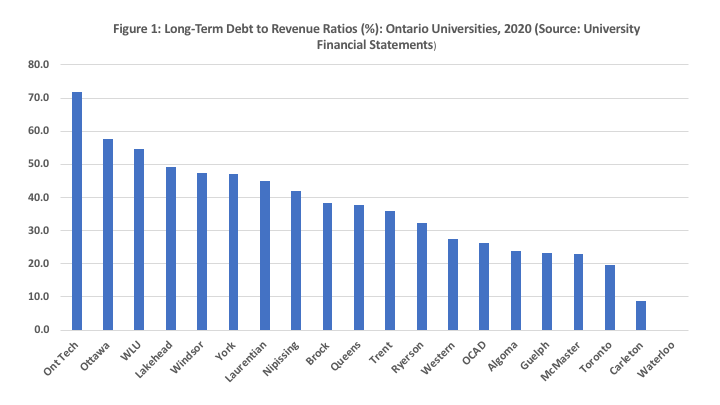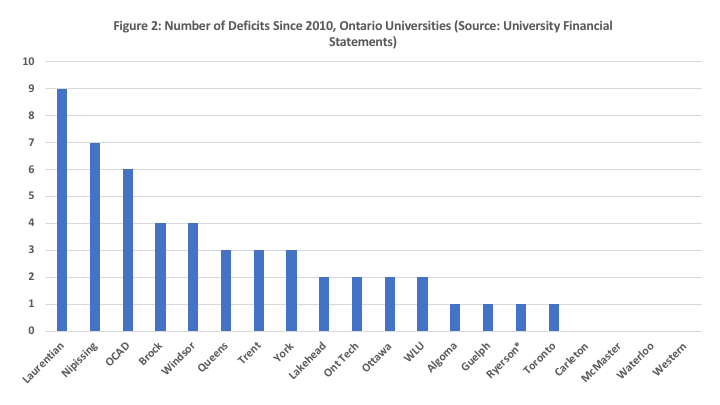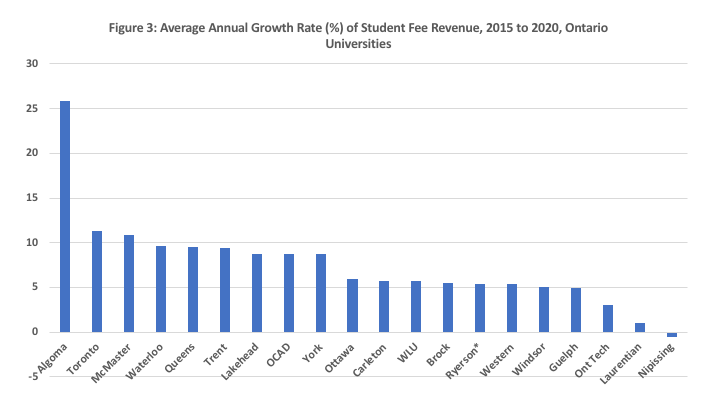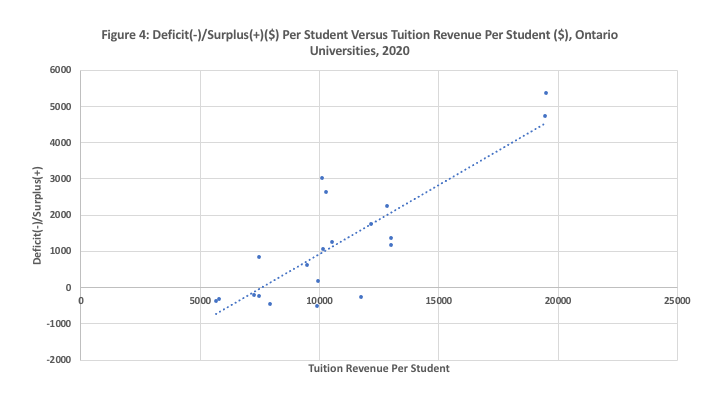Bloated administrations and poor government policy bleeding Ontario’s universities

Laurentian University recently filed for insolvency and creditor protection, sparking concerns that other Ontario universities may have financial problems and be close to the brink. While much has been made about COVID-19’s impact on university finance, it remains that Laurentian is probably unique with its long-term and structural problems including years of deficits, weak tuition revenue and low student enrolment growth.
At the same time, provincial government policy has definitely affected the financial sustainability of universities in Ontario.
Using assorted indicators constructed from the consolidated financial statements for Ontario universities available on their websites, the following charts rank the financial performance of universities. The first chart plots the ratio of long-term debt-to-revenue as an indicator of the indebtedness of universities.

The second chart plots the number of deficits incurred by each university since 2010 (with Ryerson* only available for the last three years).

The third chart presents the average annual growth rate of student fee revenue from 2015 to 2020 as an indicator of recent revenue growth (with Ryerson again only available for the last three years). The most indebted universities are Ontario Tech, Ottawa, Wilfrid Laurier, Lakehead and Windsor. Interestingly, Laurentian is mid-ranked with respect to long-term debt suggesting this is not the source of the school’s current dilemma. It should be noted that long-term debt is not all of a university’s labilities (for example, the cost of pensions and other employee liabilities are omitted). Nevertheless, some universities have more long-term debt than others, but much of this has been acquired to finance capital infrastructure to accommodate larger enrolments. Moreover, debt has not been the source of problems per se given that interest rates are currently low and debt-servicing costs (as a share of revenue) for most universities is not that substantial.

In terms of deficits since 2010, Laurentian tops the list with nine, followed closely by Nipissing (another northern Ontario school), which comes in at seven. After that there’s the Ontario College of Art Design (OCAD), Brock and Windsor (though Brock’s deficits were incurred before 2015). At the other end of the spectrum, Carleton, McMaster, Waterloo and Western have been deficit-free since 2010. Clearly, some universities have seemingly been unable to balance their budgets over the long term, which is more indicative of a structural problem.
Finally, for the average annual growth rate of student fee revenue since 2015, another northern Ontario university—Algoma—does the best, in the wake of it opening a satellite campus in Brampton. Followed by (with more than 5 per cent annual tuition revenue growth) are Toronto, McMaster, Waterloo, Queens, Trent, Lakehead, OCAD and York. The weakest performers are Ontario Tech, Laurentian and Nipissing.
Tuition revenue growth is important given that government grants have been frozen for years. Indeed, universities have seen their own-source revenue share of total revenues rise over the years. In closing any gap between revenues and spending, growing student fee revenues by increasing enrolment keeps you ahead of the problem. And it’s no secret that most of the growth in student tuition revenues have come from rising numbers of international students. Falling behind here—as appears to be the case with Laurentian—simply allows deficit problems to add up.
Indeed, the final chart highlights the link between tuition and deficits. The deficit/surplus per enrolled student is plotted against the average tuition revenue per enrolled student, and the results show a positive relationship.

In other words, those universities able to recruit larger numbers of higher-tuition paying international students have boosted their average tuition revenues per student and increased the likelihood of having surpluses as opposed to deficits. This has really been the only road ahead, and a challenging one, with the pandemic’s effects on international student recruitment and retention. This comes on top of the fact that the university operating environment in Ontario has become increasingly difficult given the provincial government’s arbitrary and inconsistent actions.
Government in Ontario has been a contributing factor to the woes of the university sector by cutting domestic student tuition 10 per cent then freezing it to score political points while also freezing grant revenue for years. Queen’s Park wants universities to be more self-reliant and operate like businesses but then wants to direct their outcomes. Over the years, the government has increasingly subjected universities to increasing regulatory and planning burdens in the name of accountability, and encouraged the pursuit of assorted public policy goals. In the end, many universities have diluted their core teaching and basic research mission to effectively become flavour-of-the-month applied arms of government and in the process acquired large bureaucracies and rising administrative compliance costs.
At least one astute observer has noted that universities are now over-governed with high administrative and overhead costs, and any reforms of the university sector must reduce the costs of this over-governance. There’s simply too much management with numerous deans, executive deans, vice-deans, vice-presidents, vice-provosts and “special advisors” and their associated retinues of assistants, coordinators, facilitators and government liaison officers. All the tuition revenue in the world will never be enough to feed this vast army of administrators.

